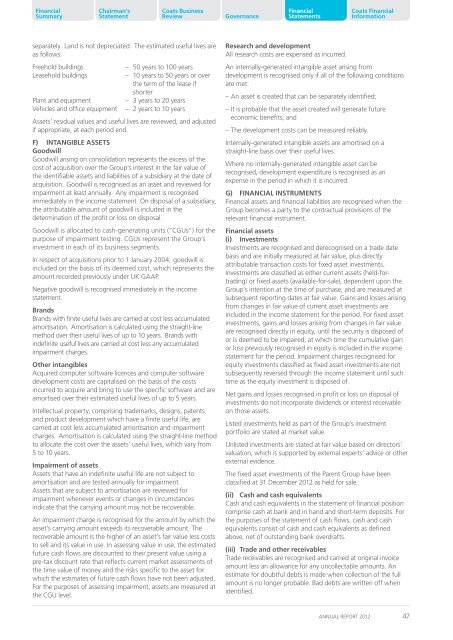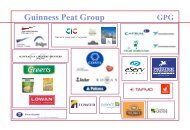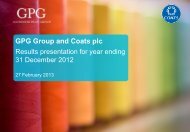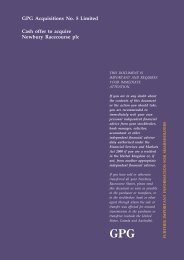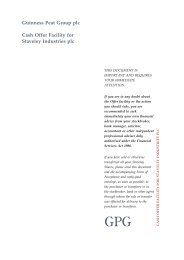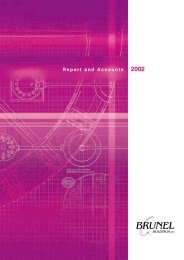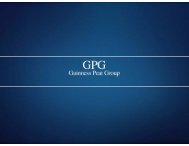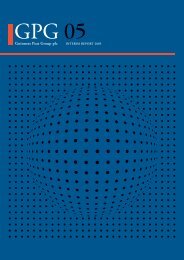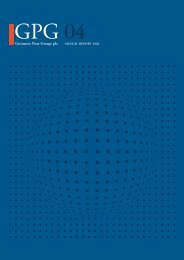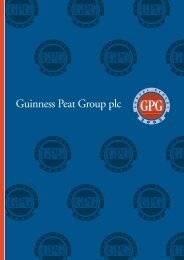Notes to Financial Statements continuedAssociated undertakingsThe <strong>Group</strong>’s investment in associated undertakings is accountedfor under the equity method of accounting. These are entities inwhich the <strong>Group</strong> has the ability to exert significant influence andwhich are neither subsidiaries nor joint ventures. The investment inassociated undertakings is carried in the statement of financialposition at cost plus post-acquisition changes in the <strong>Group</strong>’s shareof net assets of the associated undertakings, less any impairmentin value. The income statement reflects the share of the results ofoperations of associated undertakings, together with any negativegoodwill arising on acquisition and any impairment recorded bythe <strong>Group</strong>.If the <strong>Group</strong>’s share of losses exceeds the carrying amount of anassociated undertaking, the carrying amount is reduced to niland recognition of further losses is discontinued except to theextent that the <strong>Group</strong> has incurred obligations in respect of theundertaking.Where there has been a change recognised directly in theassociated undertaking’s equity, the <strong>Group</strong> recognises its shareof any changes and discloses this, where applicable, in thestatement of comprehensive income.Joint venturesJoint venture arrangements that involve the establishmentof a separate entity in which each venturer has an interest areaccounted for using the equity method as allowed under the‘alternative accounting rules’ set out in IAS 31 – Interests in JointVentures.Where a <strong>Group</strong> entity undertakes its activities under joint venturearrangements directly, the <strong>Group</strong>’s share of jointly controlledassets and any liabilities incurred jointly with the other venturersare recognised in the financial statements. Liabilities andexpenses incurred directly in respect of interests in jointlycontrolled assets are accounted for on an accruals basis. Incomefrom the sale or use of the <strong>Group</strong>’s share of the output of jointlycontrolled assets, and its share of joint venture expenses, arerecognised when it is probable that the economic benefitsassociated with the transactions will flow to/from the <strong>Group</strong> andtheir amount can be reliably measured.Going concernGiving due consideration to the nature of the <strong>Group</strong>’s businessand underlying investments, and taking account of the followingmatters: the ability of the Parent <strong>Group</strong> to realise its liquidinvestments and to manage the timing of such liquidations; theuncertainty inherent in the capital markets in which it operates;the <strong>Group</strong>’s foreign currency exposures; the potentialrequirement to provide funding to the <strong>Group</strong>’s defined benefitpension schemes; and also taking into consideration the cashflow forecasts prepared by the <strong>Group</strong> and the sensitivity analysisassociated therewith, the directors consider that the Companyand the <strong>Group</strong> are going concerns and this financial informationis prepared on that basis. Further detail is contained in theCorporate Governance report on page 31.C) FOREIGN CURRENCIESForeign currency translationThe Company’s functional and the <strong>Group</strong>’s presentation currencyis the Pound Sterling. Transactions in foreign currencies arerecorded at the rate ruling at the date of the transaction.Monetary assets and liabilities denominated in foreign currenciesare translated at the rates of exchange ruling at the period end.All currency differences on monetary items are taken to theincome statement with the exception of differences onreceivables and payables that represent a net investment in aforeign operation, which are taken directly to equity untildisposal of the net investment, at which time they are recycledthrough the income statement.Non-monetary items that are measured in terms of historical costin a foreign currency are translated using the exchange rate as atthe date of initial transaction.<strong>Group</strong> companiesAssets and liabilities of subsidiaries whose presentation currencyis not the Pound Sterling are translated into the <strong>Group</strong>’spresentation currency at the rates of exchange ruling at theperiod end and their income statements are translated at theaverage exchange rates for the year. The exchange differencesarising on the retranslation since 1 January 2004 are taken to aseparate component of equity. On disposal of such an entity, thedeferred cumulative amount recognised in equity since 1 January2004 relating to that particular operation is recycled through theincome statement. Translation differences that arose before the dateof transition to IFRS in respect of all such entities are not presentedas a separate component of equity.Goodwill and fair value adjustments arising on acquisition ofsuch operations are regarded as assets and liabilities of theparticular operation, expressed in the currency of the operationand recorded at the exchange rate at the date of the transactionand subsequently retranslated at the applicable closing rates.D) SEGMENT REPORTINGOperating segments are the components of the <strong>Group</strong> aboutwhich separate financial information is available that is evaluatedregularly by the GPG directors in deciding how to allocateresources and in assessing performance. The informationpresented within the operating segment analysis is reported onthe same basis as that used internally by the GPG directors inevaluating operating segment performance.E) PROPERTY, PLANT AND EQUIPMENTOwned assetsItems of property, plant and equipment are stated at cost lessaccumulated depreciation and any accumulated impairments.Leased assetsFinance leases, which transfer to the <strong>Group</strong> substantially all therisks and benefits of ownership of the leased items, arecapitalised at the inception of the lease at the fair value of theleased property or, if lower, at the present value of the minimumlease payments. Lease payments are apportioned between thefinance charges and reduction of the lease liability so as toachieve a constant rate of interest on the remaining balance ofthe liability. Finance charges are charged directly against income.Capitalised leased assets are depreciated over the shorter of theestimated useful life of the asset or the lease term. Leases wherethe lessor retains substantially all the risks and benefits ofownership of the asset are classified as operating leases.Operating lease payments are recognised as an expense in theincome statement on a straight-line basis over the lease term.Subsequent expenditureExpenditure incurred to replace a component of an item ofproperty, plant and equipment that is accounted for separately,including major inspection and overhaul expenditure, iscapitalised. Other subsequent expenditure is capitalised onlywhen it increases the future economic benefits embodied in theitem of property, plant and equipment. All other expenditure isrecognised in the income statement as an expense as incurred.DepreciationDepreciation is charged to the income statement on a straightlinebasis over the estimated useful lives of property, plant andequipment, and major components that are accounted for46 GUINNESS PEAT GROUP PLC
FinancialHighlights SummaryChairman’sStatementCoats BusinessReviewGovernanceFinancialStatementsCoats FinancialInformationseparately. Land is not depreciated. The estimated useful lives areas follows:Freehold buildingsLeasehold buildingsPlant and equipmentVehicles and office equipment– 50 years to 100 years– 10 years to 50 years or overthe term of the lease ifshorter– 3 years to 20 years– 2 years to 10 yearsAssets’ residual values and useful lives are reviewed, and adjustedif appropriate, at each period end.F) INTANGIBLE ASSETSGoodwillGoodwill arising on consolidation represents the excess of thecost of acquisition over the <strong>Group</strong>’s interest in the fair value ofthe identifiable assets and liabilities of a subsidiary at the date ofacquisition. Goodwill is recognised as an asset and reviewed forimpairment at least annually. Any impairment is recognisedimmediately in the income statement. On disposal of a subsidiary,the attributable amount of goodwill is included in thedetermination of the profit or loss on disposal.Goodwill is allocated to cash-generating units (“CGUs”) for thepurpose of impairment testing. CGUs represent the <strong>Group</strong>’sinvestment in each of its business segments.In respect of acquisitions prior to 1 January 2004, goodwill isincluded on the basis of its deemed cost, which represents theamount recorded previously under UK GAAP.Negative goodwill is recognised immediately in the incomestatement.BrandsBrands with finite useful lives are carried at cost less accumulatedamortisation. Amortisation is calculated using the straight-linemethod over their useful lives of up to 10 years. Brands withindefinite useful lives are carried at cost less any accumulatedimpairment charges.Other intangiblesAcquired computer software licences and computer softwaredevelopment costs are capitalised on the basis of the costsincurred to acquire and bring to use the specific software and areamortised over their estimated useful lives of up to 5 years.Intellectual property, comprising trademarks, designs, patentsand product development which have a finite useful life, arecarried at cost less accumulated amortisation and impairmentcharges. Amortisation is calculated using the straight-line methodto allocate the cost over the assets’ useful lives, which vary from5 to 10 years.Impairment of assetsAssets that have an indefinite useful life are not subject toamortisation and are tested annually for impairment.Assets that are subject to amortisation are reviewed forimpairment whenever events or changes in circumstancesindicate that the carrying amount may not be recoverable.An impairment charge is recognised for the amount by which theasset’s carrying amount exceeds its recoverable amount. Therecoverable amount is the higher of an asset’s fair value less coststo sell and its value in use. In assessing value in use, the estimatedfuture cash flows are discounted to their present value using apre-tax discount rate that reflects current market assessments ofthe time value of money and the risks specific to the asset forwhich the estimates of future cash flows have not been adjusted.For the purposes of assessing impairment, assets are measured atthe CGU level.Research and developmentAll research costs are expensed as incurred.An internally-generated intangible asset arising fromdevelopment is recognised only if all of the following conditionsare met:– An asset is created that can be separately identified;– It is probable that the asset created will generate futureeconomic benefits; and– The development costs can be measured reliably.Internally-generated intangible assets are amortised on astraight-line basis over their useful lives.Where no internally-generated intangible asset can berecognised, development expenditure is recognised as anexpense in the period in which it is incurred.G) FINANCIAL INSTRUMENTSFinancial assets and financial liabilities are recognised when the<strong>Group</strong> becomes a party to the contractual provisions of therelevant financial instrument.Financial assets(i) InvestmentsInvestments are recognised and derecognised on a trade datebasis and are initially measured at fair value, plus directlyattributable transaction costs for fixed asset investments.Investments are classified as either current assets (held-fortrading)or fixed assets (available-for-sale), dependent upon the<strong>Group</strong>’s intention at the time of purchase, and are measured atsubsequent reporting dates at fair value. Gains and losses arisingfrom changes in fair value of current asset investments areincluded in the income statement for the period. For fixed assetinvestments, gains and losses arising from changes in fair valueare recognised directly in equity, until the security is disposed ofor is deemed to be impaired, at which time the cumulative gainor loss previously recognised in equity is included in the incomestatement for the period. Impairment charges recognised forequity investments classified as fixed asset investments are notsubsequently reversed through the income statement until suchtime as the equity investment is disposed of.Net gains and losses recognised in profit or loss on disposal ofinvestments do not incorporate dividends or interest receivableon those assets.Listed investments held as part of the <strong>Group</strong>’s investmentportfolio are stated at market value.Unlisted investments are stated at fair value based on directors’valuation, which is supported by external experts’ advice or otherexternal evidence.The fixed asset investments of the Parent <strong>Group</strong> have beenclassified at 31 December 2012 as held for sale.(ii) Cash and cash equivalentsCash and cash equivalents in the statement of financial positioncomprise cash at bank and in hand and short-term deposits. Forthe purposes of the statement of cash flows, cash and cashequivalents consist of cash and cash equivalents as definedabove, net of outstanding bank overdrafts.(iii) Trade and other receivablesTrade receivables are recognised and carried at original invoiceamount less an allowance for any uncollectable amounts. Anestimate for doubtful debts is made when collection of the fullamount is no longer probable. Bad debts are written off whenidentified.ANNUAL REPORT 201247


